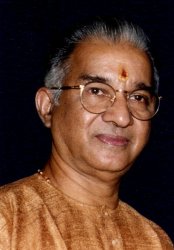
|
 |

|
 |
Creativity in naatya compositions - VP Dhananjayan, Chennai e-mail: bkalanjali@gmail.com February 8, 2010  The word choreography means "creating graphic designs on stage" or the art of composing and arranging dances. Picturesque placement of actors /dancers on a given stage frame. Or making beautiful, aesthetic and appealing designs with human body. This is totally a western concept. Until recently, this term was not applied in Indian context of theatre. Though we have all been an integral part of Rukmini Devi's dance drama productions since 1953, we were ignorant of this word "choreography" nor did she credit herself to be a "choreographer." We were familiar with the word "composing" or dance drama composition. In the western world, a "choreographer" is an important entity in a theatrical production, and he or she is regarded as the creator of the production. The success or failure of the production mainly depends upon him/her. To get recognition and respect in the western world, our artistes also started referring to themselves with this hallowed title as "choreographer." While in the West a very highly creative and experienced artiste alone is respectfully accredited with the title "choreographer," we in India use this word for all and sundry, no matter how worthy or experienced he or she is. According to me, choreography is not just composing a jathi with adavus and permutations of rhythmic calculations or composing mudras (gestures) for a song. This needs a deeper understanding of the subject matter taken for "Naatya" composition. Our Naatya is not just physical or body framework. This involves physical, mental and spiritual dimensions - Nritta (physical), Nritya (mental or thinking) and Naatya (spiritual elevation through thematic communications). While venturing to compose a piece of song, the composer should thoroughly construe the deeper meaning of the poetry and poet's imaginations, context, the situation, mood, character and so on and so forth. Then the music, raga, taala etc, appropriate postures suitable to the character and also the body of the artiste etc. In the context of our almost four decades of choreographic ventures, we have tried various trial and error methods in choreography and presentation without abandoning the basic values of our ethos and cultural integrity. A judicious admixture of lakshana (grammar and technique), lakshya (technique sans textual rigidity) and swaanubhava (self experience) have given a new dimension to the art form (naatya) to enrich it and carry it to the three grades of rasikas namely uttama, madhyama and adhama. Ultimately, what I think is, the choreography (more appropriately "a composition") should touch the hearts of the onlookers. I have no apprehensions whatsoever to say that our generation of performing artistes have been trend setters in giving graphic designs to solo items, duo items and group items and certainly more creative and innovative both technically and rhythmic complications than our predecessors. And the present generation is greater than our generation in creating patterns with body lines and rhythmic complications. But the fast paced creativity in the form of choreography in our Naatya system does not evoke 'rasaanubhoothi"(experience of sublimity). They remain at physical level following the western concept of simply entertainment. Naatya should be educative, enlightening and entertaining. These are the three dimensional aspect of choreography. Choreography should communicate what it means, and nothing should be left to the imaginations of the rasika. This is the philosophy of Bhaarateeya kalaa and samskaara (art and culture). Bharatanatyam guru VP Dhananjayan is the director of Bharata Kalanjali in Chennai. |